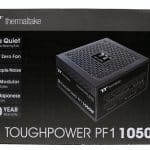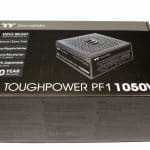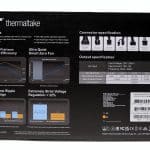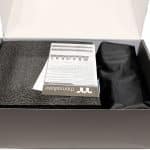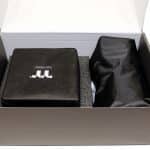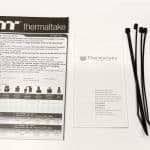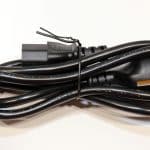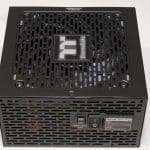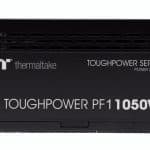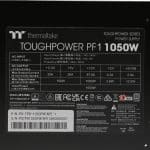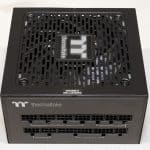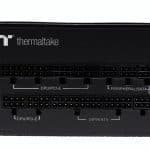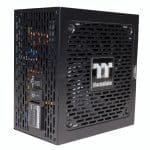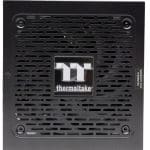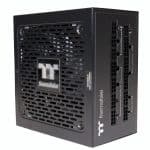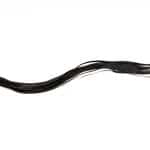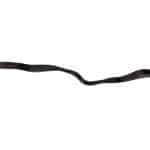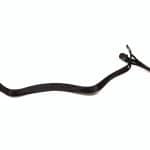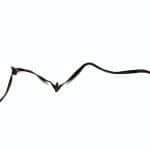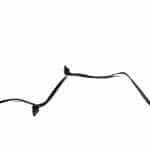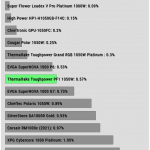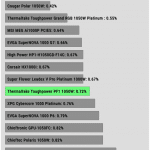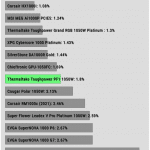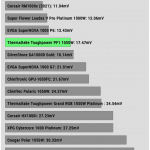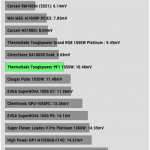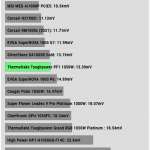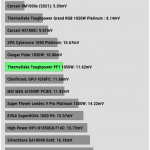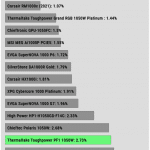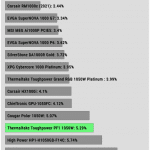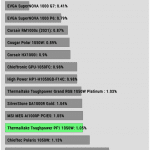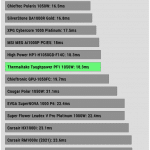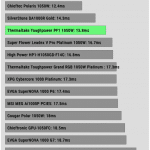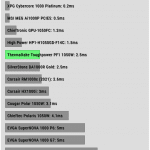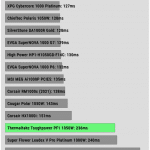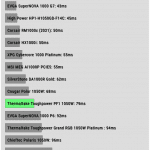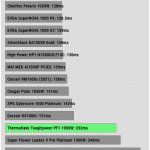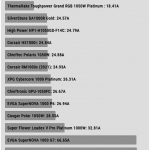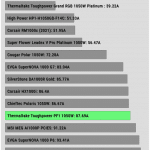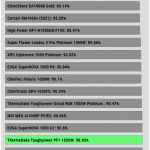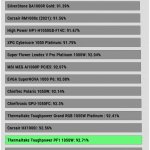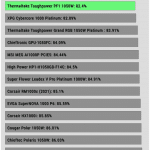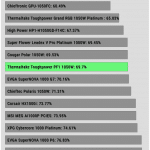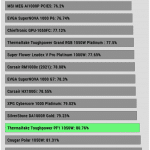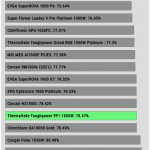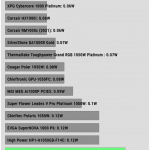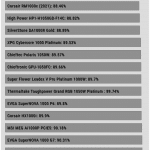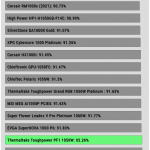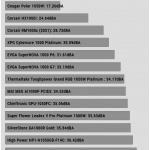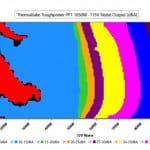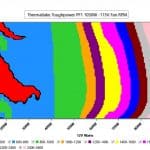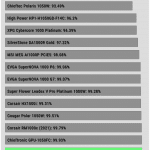The Thermaltake Toughpower PF1 model with 1050 max power is a new addition in the brand’s portofolio, offering high performance but lacking the highly desired PCIe 5.0 connector. Noise output could be lower, too.Thermaltake has been pushing many new models recently, and I am lucky enough to have most of them in the lab, so you should expect many TT reviews in the following weeks and months. My only problem is the available time since I have to split it between reviews here and videos on our YouTube channels, Hardware Busters and Hardware Busters International. But this is another story. Back to the test subject of today’s review, the Thermaltake Toughpower PF1 1050. The PSU is based on a platform provided by HKC, which has recently delivered good results, gaining popularity. The efficiency level is Platinum in both 80 PLUS and Cybenetics schemes. Regarding noise, TT and HKC didn’t pay much attention, unfortunately, so the PSU is rated as Cybenetics Standard+, meaning close to 40 dBA average noise output, which is high. The PSUs tiny footprint, only 140mm in depth, doesn’t help the fan speed profile. Compact dimensions in powerful PSUs lead to overpopulated PCBs, so airflow isn’t ideal.
 Cybenetics Report
Cybenetics Report
Technical Specifications:
- Manufacturer (OEM): HKC
- Max Power: 1050W
- Cybenetics Efficiency: [115V] Platinum (89-91%), [230V] Platinum (91-93%)
- 80 Plus Efficiency: Platinum
- Noise: Cybenetics Standard+ (35 – 40 dBA)
- Compliance: ATX12V v2.53, EPS 2.92
- Alternative Low Power Mode support: Yes
- Power 12V: 1050W
- Power 5V + 3.3V: 100W
- Power 5VSB: 12.5W
- Cooling: 120mm Hydraulic Bearing Fan [TT-1225(A1225M12S)]
- Semi-Passive Operation: Yes (Selectable)
- Modular Design: Yes (Fully)
- High Power Connectors: 2x EPS (2x cables), 8x PCIe 6+2 pin (4x cables)
- Peripheral Connectors: 12x SATA (3x cables), 4x 4-pin Molex (single cable)
- ATX/EPS Cable Length: 600/650mm
- Distance between SATA & Molex connectors: 150mm
- In-cable capacitors: No
- Dimensions (W x H x D): 150 x 85 x 140mm
- Weight: 1.69 kg (3.73 lb)
- Warranty: 10 years
Box & Bundle
The package offers adequate protection, which is the most important. At its front, we find a photo of the PSU with the modular panel in sight and a short feature list. Shame that TT doesn’t use its Cybenetics badges on the box from the moment it goes the extra mile and certifies most of its products, including this model.Product Photos
This is a compact PSU with only 140mm depth. They keep on making them smaller and smaller! EVGA’s SuperNOVA 1000 G7 has 10mm less depth! The PF1 1050 has a restrictive fan grille, and the massive badge at its center doesn’t help airflow. The same goes for the exhaust grille. The good thing is that there is a switch to toggle on/off the unit’s semi-passive operation.
Cables
All cables are flat, stealth, and pretty long. You will also be pleased to know that there are no in-cable caps, which can make cable routing a nightmare. Moreover, TT is among the few brands offering an adequately long distance among all peripheral connectors. The only problem here is that there is no 12VHPWR connector. You should expect a new version of this PSU soon with this connector.Protection Features
| OCP (Cold @ 29°C) | 12V: 114.4A (130.74%), 11.958V 5V: 29.1A (145.5%), 5.019V 3.3V: 29.2A (146%), 3.334V 5VSB: 4.5A (180%), 4.921V |
| OCP (Hot @ 41°C) | 12V: 114.6A (130.97%), 11.978V 5V: 28A (140%), 5.021V 3.3V: 29.1A (145.5%), 3.335V 5VSB: 4.5A (180%), 4.922V |
| OPP (Cold @ 29°C) | 1351.1W (128.68%) |
| OPP (Hot @ 40°C) | 1372.7W (130.73%) |
| OTP | ✓ (168°C @ secondary side) |
| SCP | 12V to Earth: ✓ 5V to Earth: ✓ 3.3V to Earth: ✓ 5VSB to Earth: ✓ -12V to Earth: ✓ |
| PWR_OK | Accurate but lower than 16ms |
| NLO | ✓ |
| SIP | Surge: MOV Inrush: NTC Thermistor & Bypass relay |
Part Analysis
| General Data | – |
| Manufacturer (OEM) | HKC |
| PCB Type | Double Sided |
| Primary Side | – |
| Transient Filter | 4x Y caps, 2x X caps, 2x CM chokes, 1x MOV |
| Inrush Protection | NTC Thermistor MF72-5D15 (5 Ohm) & Relay |
| Bridge Rectifier(s) |
2x GBU2506L (600V, 25A @ 100°C) |
| APFC MOSFETs |
2x Lonten LSD65R099GF (650V, 26A @ 100°C, Rds(on): 0.099Ohm) |
| APFC Boost Diode |
1x Global Power Technology G3S06510A (650V, 10A @ 155°C) |
| Bulk Cap(s) |
1x Nichicon (400V, 1,000uF, 2,000h @ 105°C, GG) |
| Main Switchers |
4x Lonten LSD55R140GF (550V, 15A @ 100°C, Rds(on): 0.14Ohm) |
| APFC Controller |
Champion CM6500UNX & CM03AX |
| Resonant Controller | Champion CM6901T6X |
| Topology |
Primary side: APFC, Full-Bridge & LLC converter
Secondary side: Synchronous Rectification & DC-DC converters |
| Secondary Side | – |
| +12V MOSFETs | 8x Infineon BSC014N04LS (40V, 125A @ 100°C, Rds(on): 1.4mOhm) |
| 5V & 3.3V | DC-DC Converters |
| Filtering Capacitors | Electrolytic: 3x Nichicon (10,000h @ 105°C, HW), 1x Rubycon (6-10,000h @ 105°C, ZLH), 5x Nippon Chemi-Con (4-10,000h @ 105°C, KY), 1x Nippon Chemi-Con (4-10,000h @ 105°C, KYA) Polymer: 31x Teapo |
| Supervisor IC | Grenergy GR8329N (OCP, OVP, UVP, SCP, PG) |
| Fan Model | Thermaltake TT-1225 (A1225M12S) (120mm, 12V, 0.38A, Hydraulic Bearing Fan) |
| 5VSB Circuit | – |
| Rectifier | 1x CRMicro CRTD045N03L (30V, 93A @ 100°C, Rds(on): 4.5mOhm) FET |
| Standby PWM Controller | Sanken STR-A6069H |
| -12V Circuit | – |
| Rectifier |
1x |
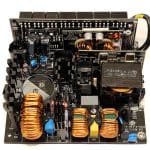
top1
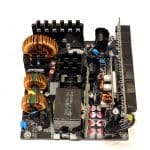
top2

top3
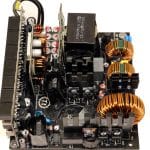
top4
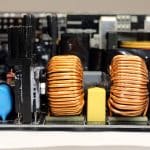
transientb1
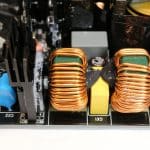
transientb2
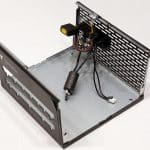
transienta1

transienta2

MOV
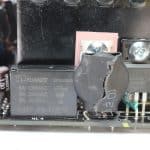
NTC_thermistor_relay
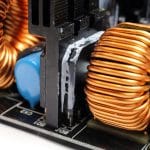
bridges1
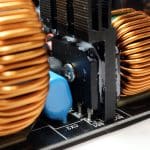
bridges2
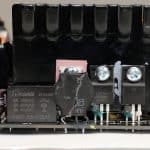
APFC_side
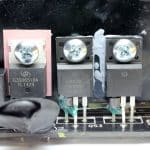
APFC_FETs

APFC_controllers
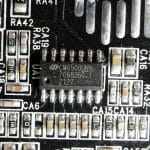
APFC_CM6500UNX
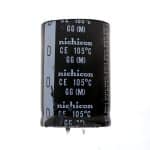
APFC_bulk_cap
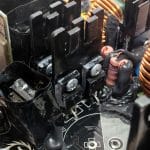
primary_FETs

resosnant_tank
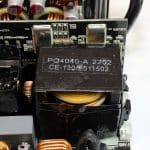
main_transformer
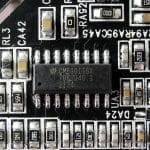
CM6901
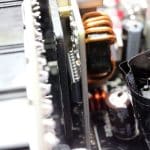
Controller

VRMs1
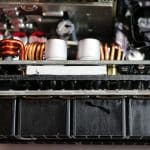
VRMs2

caps1
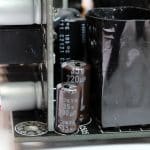
caps3
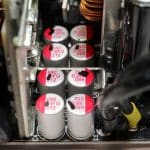
caps4
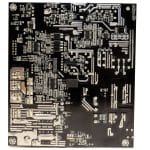
main1
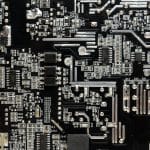
main2
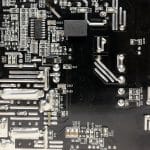
main3
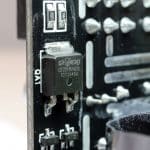
CRTD045N03L_FET
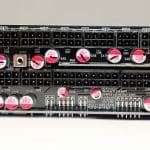
modular1
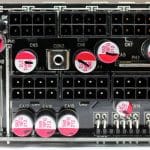
modular2
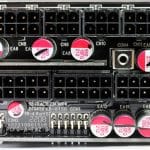
modular3
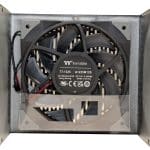
fan1
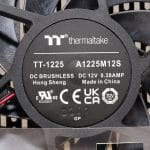
fan2
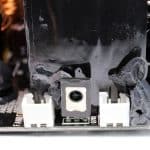
fan_controller
Testing Methodology
I follow Cybenetics’ PSU testing methodology since I use the same labs. Moreover, the same methodology describes the performance algorithm that I use to extract overall performance. This algorithm has been updated several times, so in some cases, where I have to include some older products, I have to use older versions. This is why in some reviews, you might notice deviations in overall performance compared to other reviews. Finally, if you are wondering about my equipment, you can look at the following scheme.
Load Regulation
Load regulation is tight enough.Ripple Suppression
Ripple suppression is good.Transient Response
The results are not so good here, especially on the minor rails, which will cost several performance points.Hold Up Time
The hold-up time is long enough, and the power ok signal is accurate. The latter fails to reach 16ms for only 0.2ms, so I will let this slide.Timings
The PSU doesn’t support Alternative Low Power Modes, which is weird, given that it is a new model.Inrush Current
Inrush currents are high.Efficiency Normal, Light & Super-Light Loads
The platform is efficient. There is room for improvement at light loads, though.
Average Efficiency 5VSB
The 5VSB rail achieves high efficiency.Vampire Power
Vampire power should be below 0.1W, especially with 115V input.Average Efficiency
The platform is highly efficient, leading the category with 115V.Average PF
The APFC converter has decent performance, but there is room for improvement, especially with 230V input.Average Noise
The average noise output is sky-high!Fan Noise & Speed Maps @ 28-32 °C
The semi-passive operation doesn’t last long and has a weird operation. With more than 590W, the PSU’s fan exceeds 30 dBA; with around 650W, it enters the 35-40 dBA zone. The party starts with more than 850W, where the fan’s noise exceeds 45 dBA.Overall Performance
Despite the not-so-good transient response, the PF1 1050 is high in the overall performance chart. With improved transient response, it would easily take the lead. HKC has started delivering amazing results, and they can do even better under the proper guidance.Epilogue
Thermaltake uses more and more HKC platforms lately, and I can see why. With a little more tuning, the PF1 1050 can easily top the performance charts, and even with its current configuration, it achieves second place! The unit is highly efficient and has tight enough load regulation and good ripple suppression, so your precious PC parts will be fed by clean voltage rails. On the other hand, if you plan on heavily pushing it, you should be prepared to get treated with a loud noise, so you will have to either use headphones and warn the neighbors or have a good sound system that will cover the PSU’s noise. Although Thermaltake cooperates with Cybenetics, it doesn’t pay the required attention to the LAMBDA noise certification, and this is a shame because most users nowadays want silent PC parts. I remember that many years ago, I didn’t care either much about noise output. I could sleep with a Delta fan screaming one meter away from me, but these computing days have long passed, thankfully, and currently, I cannot stand loud PC components. Buy Thermaltake Toughpower PF1 ARGB 1050W Buy Corsair HX1000i Buy Corsair RM1000x Buy EVGA 1000 P6 Buy ASUS Rog Strix 1000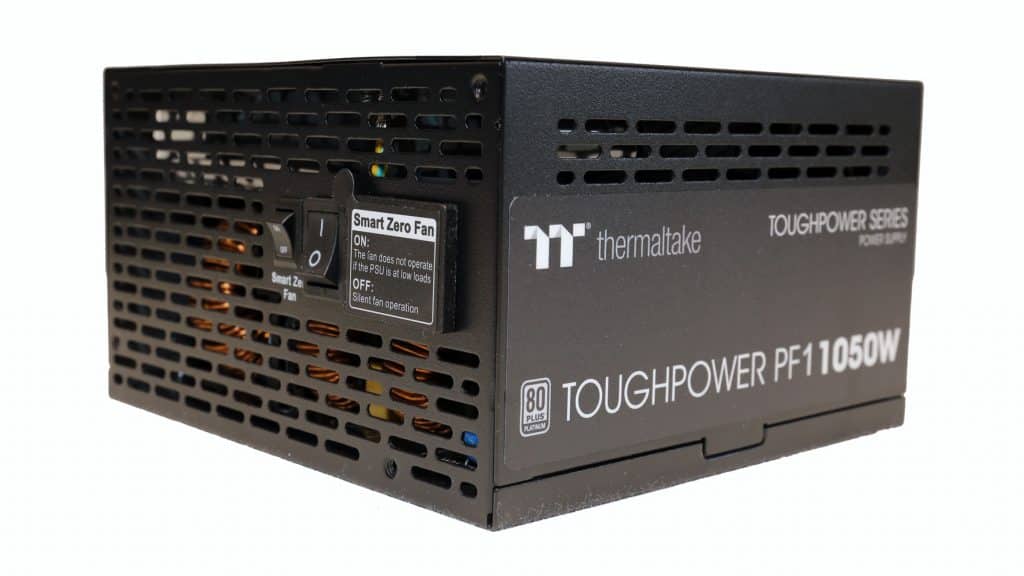
Pros:
- Full power at 47°C
- High overall performance
- Efficient
- Highly efficient 5VSB rail
- High build quality
- Capable APFC converter
- Tight enough load regulation
- Good ripple suppression
- Longer than 17ms hold-up time
- Accurate power ok signal
- Adequate distance between the peripheral connectors
- FDB fan
- Ten-year warranty
Cons:
- Not so good transient response
- Noisy fan speed profile
- No 12VHPWR connector
- No Alternative Low Power Mode (ALPM) support
- High inrush currents
- No need for such high amperage at 3.3V
- Above 0.1W vampire power with 115V and 230V

